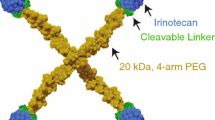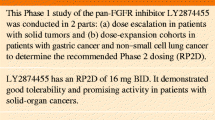Abstract
Background
S-trans,trans-farnesylthiosalicylic acid (salirasib, FTS) is a synthetic small molecule that acts as a potent Ras inhibitor. Salirasib inhibits specifically both oncogenically activated Ras and growth factor receptor-mediated Ras activation, resulting in the inhibition of Ras-dependent tumor growth. The objectives of this study were to develop a sensitive LC-MS/MS assay for determination of FTS in plasma, to assess the bioavailabilty of FTS after oral administration to mice, and then to examine the efficacy of orally administered FTS for inhibition of tumor growth in a nude mouse model.
Methods
FTS was isolated from mouse plasma by liquid chromatography on a Columbus 5-μm particle size, 50 × 2 mm id column with a methanol/5 mM ammonium acetate (80/20) mobile phase (isocratic elution) at a flow rate of 0.3 ml/min. MS/MS was performed on a PE Sciex API 365 with Turbo Ion Spray as interface and negative ion ionization; parent ion (m/z): 357.2; daughter ion (m/z) 153.2; retention time 2.3 min. For plasma analysis, the amount of analyte in each sample was calculated by comparing response of the analyte in that sample to a nine-point standard curve linear over the range 3–1000 ng/ml. Pharmacokinetic studies were performed in mice following intraperitoneal dosing (20 mk/kg in PBS) or oral dosing (40 mg/kg in either 0.5% aqueous CMC or corn oil). Panc-1 tumor growth in nude mice was determined following daily oral dosing with FTS in 0.5% CMC (40, 60, or 80 mg/kg), or in combination with weekly gemcitabine (30 mg/kg).
Results
Salirasib was readily detected in mouse plasma by LC-MS/MS at a detection limit of 3 ng/ml. For each route of administration, t max was 1 h and t 1/2 ranged from 1.86 to 2.66 h. Compared to IP administration, the oral bioavailabilty of FTS was 69.5% for oral CMC and 55% for oral corn oil suspensions, while clearance and volume of distribution were higher in both oral preparations. The orally administered salirasib inhibited panc-1 tumor growth in a dose dependent manner (67% reduction in tumor weight at the highest dose, P < 0.002 vs. control, n = 10 mice per group) and at a 40 mg/kg daily dose was synergistic with gemcitabine (83% increase in survival rate, n = 8 mice per group).
Conclusions
Salirasib exhibits good bioavailabilty after oral administration, as determined by a highly sensitive method for quantification in plasma. The orally available Ras inhibitor salirasib inhibited growth in nude mice, and may thus be considered for clinical trials.







Similar content being viewed by others
References
Aharonson Z, Gana Weisz M, Varsano T, Haklai R, Marciano D, Kloog Y (1998) Stringent structural requirements for anti-Ras activity of S-prenyl analogues. Biochim Biophys Acta 1406:40–50
Kloog Y, Cox AD (2004) Prenyl-binding domains: potential targets for Ras inhibitors and anti-cancer drugs. Semin Cancer Biol 14:253–61
Kloog Y, Cox AD (2000) RAS inhibitors: potential for cancer therapeutics. Mol Med Today 6:398–402
Elad-Sfadia G, Haklai R, Balan E, Kloog Y (2004) Galectin-3 augments K-Ras activation and triggers a Ras signal that attenuates ERK but not phosphoinositide 3-kinase activity. J Biol Chem 279:34922–30
Elad-Sfadia G, Haklai R, Ballan E, Gabius HJ, Kloog Y (2002) Galectin-1 augments Ras activation and diverts Ras signals to Raf-1 at the expense of phosphoinositide 3-kinase. J Biol Chem 277:37169–75
Paz A, Haklai R, Elad-Sfadia G, Ballan E, Kloog Y (2001) Galectin-1 binds oncogenic H-Ras to mediate Ras membrane anchorage and cell transformation. Oncogene 20:7486–93
Blum R, Kloog Y (2005) Tailoring Ras-pathway–inhibitor combinations for cancer therapy. Drug Resist Updat 8:369–80
Yaari S, Jacob-Hirsch J, Amariglio N, Haklai R, Rechavi G, Kloog Y (2005) Disruption of cooperation between Ras and MycN in human neuroblastoma cells promotes growth arrest. Clin Cancer Res 11:4321–30
Marom M, Haklai R, Ben Baruch G, Marciano D, Egozi Y, Kloog Y (1995) Selective inhibition of Ras-dependent cell growth by farnesylthiosalisylic acid. J Biol Chem 270:22263–70
Jansen B, Schlagbauer-Wadl H, Kahr H, Heere-Ress E, Mayer BX, Eichler H, Pehamberger H, Gana-Weisz M, Ben-David E, Kloog Y, Wolff K (1999) Novel Ras antagonist blocks human melanoma growth. Proc Natl Acad Sci U S A 96:14019–24
Elad G, Paz A, Haklai R, Marciano D, Cox A, Kloog Y (1999) Targeting of K-Ras 4B by S-trans,trans-farnesyl thiosalicylic acid. Biochim Biophys Acta 1452:228–42
Bar-Sagi D, Hall A (2000) Ras and Rho GTPases: a family reunion. Cell 103:227–38
Boguski MS, McCormick F (1993) Proteins regulating Ras and its relatives. Nature 366:643–54
Bos JL (1989) Ras oncogenes in human cancer: a review. Cancer Res 49:4682–9
Kloog Y, Cox AD, Sinensky M (1999) Concepts in Ras-directed therapy. Expert Opin Investig Drugs 8:2121–40
Bivona TG, Philips MR (2003) Ras pathway signaling on endomembranes. Curr Opin Cell Biol 15:136–42
Denis GV, Yu Q, Ma P, Deeds L, Faller DV, Chen CY (2003) Bcl-2, via its BH4 domain, blocks apoptotic signaling mediated by mitochondrial Ras. J Biol Chem 278:5775–85
Niv H, Gutman O, Henis YI, Kloog Y (1999) Membrane interactions of a constitutively active GFP-K-Ras 4B and their role in signaling: Evidence from lateral mobility studies. J Biol Chem 274:1606–13
Haklai R, Gana-Weisz G, Elad G, Paz A, Marciano D, Egozi Y, Ben Baruch G, Kloog Y (1998) Dislodgment and accelerated degradation of Ras. Biochemistry 37:1306–14
Weisz B, Giehl K, Gana-Weisz M, Egozi Y, Ben-Baruch G, Marciano D, Gierschik P, Kloog Y (1999) A new functional Ras antagonist inhibits human pancreatic tumor growth in nude mice. Oncogene 18:2579–88
Halaschek-Wiener J, Kloog Y, Wacheck V, Jansen B (2003) Farnesyl thiosalicylic acid chemosensitizes human melanoma in vivo. J Invest Dermatol 120:109–15
Blum R, Jacob-Hirsch J, Amariglio N, Rechavi G, Kloog Y (2005) Ras inhibition in glioblastoma down-regulates hypoxia-inducible factor-1alpha, causing glycolysis shutdown and cell death. Cancer Res 65:999–1006
Beiner ME, Niv H, Haklai R, Elad-Sfadia G, Kloog Y, Ben-Baruch G (2006) Ras antagonist inhibits growth and chemosensitizes human epithelial ovarian cancer cells. Int J Gynecol Cancer 16(Suppl 1):200–6
Halaschek-Wiener J, Wacheck V, Schlagbauer-Wadl H, Wolff K, Kloog Y, Jansen B (2000) A novel Ras antagonist regulates both oncogenic Ras and the tumor suppressor p53 in colon cancer cells. Mol Med 6:693–704
Erlich S, Tal-Or P, Liebling R, Blum R, Karunagaran D, Kloog Y, Pinkas-Kramarski R (2006) Ras inhibition results in growth arrest and death of androgen-dependent and androgen-independent prostate cancer cells. Biochem Pharmacol 72:427–36
Barkan B, Starinsky S, Friedman E, Stein R, Kloog Y (2006) The Ras inhibitor farnesylthiosalicylic acid as a potential therapy for neurofibromatosis type 1. Clin Cancer Res 12:5533–42
Jansen B, Heere-Ress E, Schlagbauer-Wadl H, Halaschek-Wiener J, Waltering S, Moll I, Pehamberger H, Marciano D, Kloog Y, Wolff K (1999) Farnesylthiosalicylic acid inhibits the growth of human Merkel cell carcinoma in SCID mice. J Mol Med 77:792–7
Weisz B, Giehl K, Gana-Weisz M, Egozi, Ben-Baruch G, Marciano D, Gierschik P, Kloog Y (1999) A new functional Ras antagonist inhibits human pancreatic tumor growth in nude mice. Oncogene 18:2579–88
Gana-Weisz M, Halaschek-Wiener J, Jansen B, Elad G, Haklai R, Kloog Y (2002) The Ras inhibitor S-trans, trans-farnesylthiosalicylic acid chemosensitizes human tumor cells without causing resistance. Clin Cancer Res 8:555–65
de Rooij J, Bos JL (1997) Minimal Ras-binding domain of Raf1 can be used as an activation-specific probe for Ras. Oncogene 14:623–5
Fridman M, Maruta H, Gonez J, Walker F, Treutlein H, Zeng J, Burgess A (2000) Point mutants of c-raf-1 RBD with elevated binding to v-Ha-Ras. J Biol Chem 275:30363–71
Macdonald JS, McCoy S, Whitehead RP, Iqbal S, Wade JLr, Giguere JK, Abbruzzese JL (2005) A phase II study of farnesyltransferase inhibitor R115777 in pancreatic cancer: a southwest oncology group (SWOG9924) study. Invest new drugs 23:485–87
Author information
Authors and Affiliations
Corresponding author
Rights and permissions
About this article
Cite this article
Haklai, R., Elad-Sfadia, G., Egozi, Y. et al. Orally administered FTS (salirasib) inhibits human pancreatic tumor growth in nude mice. Cancer Chemother Pharmacol 61, 89–96 (2008). https://doi.org/10.1007/s00280-007-0451-6
Received:
Accepted:
Published:
Issue Date:
DOI: https://doi.org/10.1007/s00280-007-0451-6




